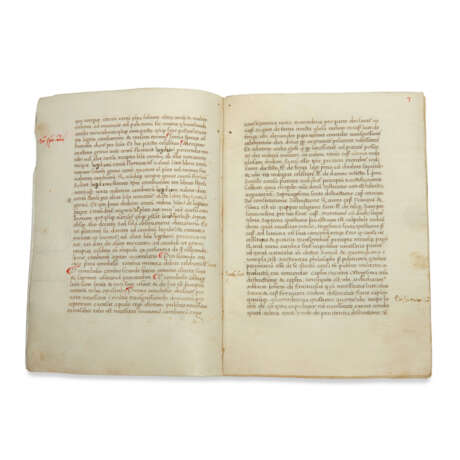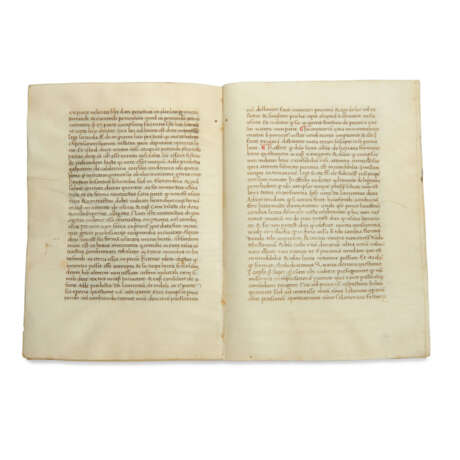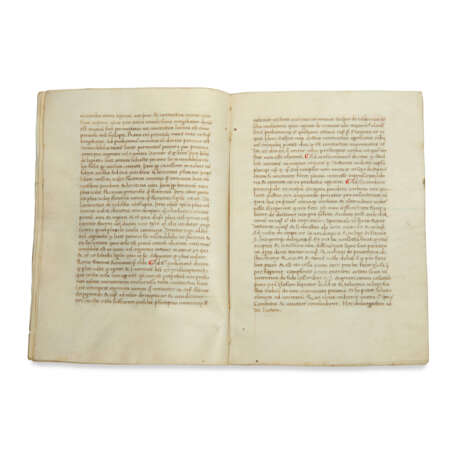ID 1105652
Lot 33 | Anonymous
Valeur estimée
£ 10 000 – 15 000
A Treatise on Commerce and Economics, in Latin, manuscript on vellum [northern Italy, end of the 15th century]
A fascinating insight into the mechanics and ethics of Renaissance mercantile commerce and financial exchange in Italy: a short, apparently unpublished treatise, handsomely written by an accomplished humanist scribe.
189 x 135mm. 16 leaves, two gatherings of 8 leaves, 30 lines in an elegant humanist hand, written space: 135 x 91mm, the text beginning '[...] ducati vel contra accepta moneta [...]' and ending 'decus et celestis curie ac animarum fidelium salutem AMEN', contemporary partial foliation in red (stopping after the third leaf), a few contemporary or near-contemporary marginal annotations in brown and red ink (lacking opening leaf, perhaps part of a larger volume). Contemporary limp vellum (a little rubbed, with a few wormholes).
Provenance:
The manuscript was most likely in northern Italy at the end of the 15th century, likely in one of the large mercantile centres such as Genoa (mentioned several times in the text) or Venice. An ownership device consisting of an inverted triangle surmounted by two circles, a cross and the letters P, C, A is drawn in brown ink on the upper cover.
Content:
This fascinating little pamphlet, anonymously authored and handsomely produced by an accomplished humanist scribe, consists of two parts: the first is a 'Tractatus cambiorum', a treatise on exchange; the second is an exploration of the Christian ethical considerations on usury, debt, and commercial transactions, heavily reliant on Canon Law and drawing on authorities such as Aristotle (ff.4v and 5v), Baldus de Ubaldi (ff.3v and 6), Giovanni d'Anagni (d.1457) and Lorenzo Ridolfi (d. c.1450, on whom see L. Armstrong, Usury and public debt in early Renaissance Florence: Lorenzo Ridolfi on the Monte Comune, 2004). The anonymous author mentions an apostolic letter on these matters issued by the late Pope Sixtus IV (1471-1484), which allows us to date the composition of the pamphlet.
All contemporary authors who dealt with the theory of financial exchange divided it into three kinds: ordinary exchange of the moneys of different currencies ('cambium minutum'); exchange of moneys of different currencies between different places, the justification for which rested on remuneration for an imaginary transport ('cambium per litteras'); and usurious exchange of moneys of the same currency ('cambium siccum'). The former two species of 'cambium' were justifiable, whereas the last was condemned: 'omnino illicita sunt et sapiunt usuariam pravitatem' (on this, see Lorenzo Ridolfi, De Usuris, III, nos. 1 to 5). Presumably the missing opening leaf of the present pamphlet addressed the intricacies of 'cambium minutum'; on f.2 (our first leaf) the author sets out a definition of 'cambium siccum', or 'dry exchange', here also called 'cambium per venetias' ('cambio veneziano' in Italian), where in the case that a bill of exchange was used as a loan, it was often guaranteed by means of a preliminary agreement in which the parties established the amount of the return exchange. This was a practice that met with strong condemnation on the part of the Church, as the parties could conceal the interest rate in the exchange rate of the second bill (on this, see the Dominican Thomas de Vio's [1469-1534], better known as Cardinal Cajetan, treatise De Cambiis of 1499). The text here provides a number of practical examples of currency exchange between different places, namely Genoa, Lyon (which has been corrected in a contemporary hand from 'Lundini' to 'Lugduni'), and Alexandria, and the currencies used in these transactions, namely ducats and silver. The third kind of exchange is addressed at the end of f.2v: 'Tertia species cambiorum dicit per litteras', or exchange by bills.
| Adresse de l'enchère |
CHRISTIE'S 8 King Street, St. James's SW1Y 6QT London Royaume-Uni | ||||
|---|---|---|---|---|---|
| Aperçu |
| ||||
| Téléphone | +44 (0)20 7839 9060 | ||||
| Commission | see on Website | ||||
| Conditions d'utilisation | Conditions d'utilisation |





